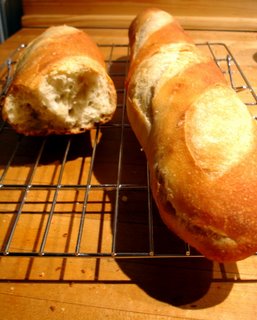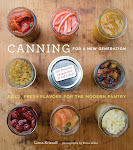Joe's French bread: Dissolve 1 sachet (1 scant tablespoon) instant yeast in 1 1/2 cups warm water, with a pinch of sugar. Let sit until it bubbles a bit, about 5 minutes. Add 1 tablespoon fine sea salt (I used coarse kosher) and 1 cup unbleached bread flour (I used White Lily, but the new Gold Medal with a bit of barley in it was recommended). Beat with a wooden spoon for a minute or so. Add 2 to 3 cups more flour, to make a somewhat stiff dough; knead for 5 to 10 minutes, until no longer sticky. Let rise for a couple hours. (Apparently a second rising works better, but I just did one.)A few days later, I made rye bread using the cold oven technique—it worked really well, I think. I used maybe 1 cup of rye flour, the rest regluar bread flour, and added 1 1/2 tablespoons caraway seeds. Oh, and I used about a cup of sourdough starter and just 1/2 tablespoon yeast. Let it sit all day in the fridge because we went out before I was able to bake it. I just finished eating the last of it and neglected to take a picture, but it looked like your basic rye bread.
Cut dough in half and roll into French loaf shapes or baguettes (Julia Child's instructions for folding, patting, rolling are worth looking at). Place in greased pans and let rise for 45 to 60 minutes. Cut deep slits in loaves and let rest for 5 minutes. Place in the middle of a cold oven and set the temperature to 400 degrees. Toss 4 or 5 ice cubes onto the floor of the oven. Bake for about 30 minutes. Add a few more ice cubes halfway through the baking to make it crustier. (I misted the oven a bit instead.) Try to let the bread cool for 20 minutes or so before slicing into it.
Monday, November 27, 2006
French Bread
Mr. Chalmers's boss was kind enough to share her beau's recipe for French bread with me, and also sent Mr. Chalmers home with a perforated French bread pan! As soon as he handed over the recipe, I started the dough. The process is simple, no-frills, and probably doesn't even require the use of the special pan (though it helps the dough keep its shape). Crust was great: crisp, shattering, and a beautiful golden color. The bread is salty, as it should be: you get lots of flavor for a plain white-flour bread. Definitely the best French bread I've made.
Saturday, November 25, 2006
Short Long Weekend
Another easy, relaxed Thanksgiving here at the Chalmerses' house; we pretty much made what we'd had last year in Florida because it was all so good then, and didn't knock ourselves out trying to make seven sweets and seven sours or anything like that. We even forwent the stuffing! Mr. Chalmers brined a turkey breast overnight, then smoked it in the backyard while the bug played in her jumper nearby. I made an apple-ginger cake with cinnamon cream cheese frosting, a lemon buttermilk pie with a lard-and-butter crust, sourdough bread (which was fine but not very sour), the fresh cranberry relish my mom has been making every Thanksgiving for a decade and a half because it goes so well with venison (even better with turkey, and still better with smoked turkey), some snap peas, and roasted acorn and butternut squash with random spices (cayenne, cumin, coriander, cinnamon, salt). Our friend Jon came by in the evening with a cranberry crumble, and we played dominoes and stayed up late—late for us, anyway.
 My old mixer was put through its paces again this year with the three-layer cake batter and a big batch of thick icing. It did just fine.
My old mixer was put through its paces again this year with the three-layer cake batter and a big batch of thick icing. It did just fine.
 I don't know why I insist on using 8-inch pans for cake recipes that call for 9-inch. I do kind of like how tall and unwieldy the cake is, though.
I don't know why I insist on using 8-inch pans for cake recipes that call for 9-inch. I do kind of like how tall and unwieldy the cake is, though.
 Here's the pastry dough I was so excited to try. I used a little more than half leaf lard and the rest butter, and a bit more salt than usual. It tasted great, I think, and was exceptionally easy to work with; baked up, it was sturdy and flaky but not nearly as tender as all- or part-shortening crusts I've made.
Here's the pastry dough I was so excited to try. I used a little more than half leaf lard and the rest butter, and a bit more salt than usual. It tasted great, I think, and was exceptionally easy to work with; baked up, it was sturdy and flaky but not nearly as tender as all- or part-shortening crusts I've made.

 We've been going on little daytrips. Friday we took the scenic route to and from Augusta, and yesterday we went to Decatur and spent a couple hours at Your Dekalb Farmer's Market, where we had lunch and bought, among other things, some tiny quail and a couple of bream (bluegill), which we grilled with lemon and basil and garlic and had for supper with the best French bread ever (more on the latter later).
We've been going on little daytrips. Friday we took the scenic route to and from Augusta, and yesterday we went to Decatur and spent a couple hours at Your Dekalb Farmer's Market, where we had lunch and bought, among other things, some tiny quail and a couple of bream (bluegill), which we grilled with lemon and basil and garlic and had for supper with the best French bread ever (more on the latter later).
The bug, possibly because of all the fun things she's been getting to do this weekend, has been sleeping very well. She slept from six last night until six this morning—straight through. Yes, twelve hours straight. (And she's napping now!) Mr. Chalmers says he heard her make a few whimpering sounds at one point when he was up anyway, but it wasn't enough to wake me up and that's what really matters. And of course because of all this wonderful sleep she's been in excellent spirits, as have we all. Even Cooper and Wagner are getting along better.
 My old mixer was put through its paces again this year with the three-layer cake batter and a big batch of thick icing. It did just fine.
My old mixer was put through its paces again this year with the three-layer cake batter and a big batch of thick icing. It did just fine. I don't know why I insist on using 8-inch pans for cake recipes that call for 9-inch. I do kind of like how tall and unwieldy the cake is, though.
I don't know why I insist on using 8-inch pans for cake recipes that call for 9-inch. I do kind of like how tall and unwieldy the cake is, though. Here's the pastry dough I was so excited to try. I used a little more than half leaf lard and the rest butter, and a bit more salt than usual. It tasted great, I think, and was exceptionally easy to work with; baked up, it was sturdy and flaky but not nearly as tender as all- or part-shortening crusts I've made.
Here's the pastry dough I was so excited to try. I used a little more than half leaf lard and the rest butter, and a bit more salt than usual. It tasted great, I think, and was exceptionally easy to work with; baked up, it was sturdy and flaky but not nearly as tender as all- or part-shortening crusts I've made.
 We've been going on little daytrips. Friday we took the scenic route to and from Augusta, and yesterday we went to Decatur and spent a couple hours at Your Dekalb Farmer's Market, where we had lunch and bought, among other things, some tiny quail and a couple of bream (bluegill), which we grilled with lemon and basil and garlic and had for supper with the best French bread ever (more on the latter later).
We've been going on little daytrips. Friday we took the scenic route to and from Augusta, and yesterday we went to Decatur and spent a couple hours at Your Dekalb Farmer's Market, where we had lunch and bought, among other things, some tiny quail and a couple of bream (bluegill), which we grilled with lemon and basil and garlic and had for supper with the best French bread ever (more on the latter later).The bug, possibly because of all the fun things she's been getting to do this weekend, has been sleeping very well. She slept from six last night until six this morning—straight through. Yes, twelve hours straight. (And she's napping now!) Mr. Chalmers says he heard her make a few whimpering sounds at one point when he was up anyway, but it wasn't enough to wake me up and that's what really matters. And of course because of all this wonderful sleep she's been in excellent spirits, as have we all. Even Cooper and Wagner are getting along better.
Friday, November 17, 2006
Après Hammock
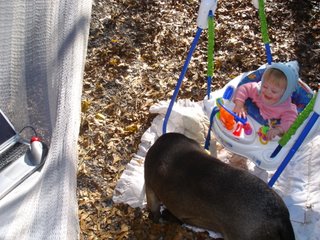 This is how I copyedit lately: I set the bug's jumper thing out in the backyard next to the hammock, with a blanket underneath it for her delicate feet. I put lots of layers on her and on me, and I sit in the hammock with my computer and she jumps and watches the dogs until I get too cold and we have to come in and eat and warm up. When she's conked out in her bed with the space heater going full blast (we just moved from Florida, remember), I make a spicy vegetable stew, the kind you eat with a fork and a hunk of bread, and get back to work.
This is how I copyedit lately: I set the bug's jumper thing out in the backyard next to the hammock, with a blanket underneath it for her delicate feet. I put lots of layers on her and on me, and I sit in the hammock with my computer and she jumps and watches the dogs until I get too cold and we have to come in and eat and warm up. When she's conked out in her bed with the space heater going full blast (we just moved from Florida, remember), I make a spicy vegetable stew, the kind you eat with a fork and a hunk of bread, and get back to work.
Vegetable stew: Make it spicy enough and it'll cure a cold. Sauté lots of garlic, 1 sliced onion, and 1 chopped potato in olive oil until the garlic is fragrant and soft. Add some canned tomatoes and a little of their juice or water, 2 coarsely chopped serrano chiles, and a big pinch of hot pepper flakes. Season with salt and black pepper. Simmer until the potato is almost tender,then add green beans (I used frozen!) and chopped fresh herbs (today I used celery-root tops and basil), and season again with salt and pepper. Simmer until the beans and potato are tender. Of course, you can add just about anything else to this you want.
I Can't Believe It's Lard! Hog: Part 2
 Tubs that used to contain dangerous quantities of butterlike spread now contain heart-healthy lard (the one on the left is still warm from being rendered and hasn't solidified).
Tubs that used to contain dangerous quantities of butterlike spread now contain heart-healthy lard (the one on the left is still warm from being rendered and hasn't solidified).My parents mailed a well-wrapped container of leaf lard to me, and last night after the bug was snug in bed I skipped around in the sections in Real Food about lard and butter and margarine. I knew that butter was better for you than margarine (Mom, Dad, I'll send you this book when I'm done), but didn't know that lard was so much better for you than margarine or shortening. I also didn't know that commercial lard, aside from tasting too porky to use in sweet pies, is partially hydrogenated! So after skimming Melissa Clark's Times article in which she tests a zillion pie crusts containing various proportions of different fats and leaf lard plus butter comes out of it the clear winner (interestingly, chopped unrendered suet does well too), I'm even more excited to try my first lard pie crust next week for Thanksgiving. What to put in that pie is an open question. Any suggestions? I really like the sound of Clark's pear and pomegranate molasses, but a good buttermilk pie would perhaps let the crust shine a bit more, and Mr. Chalmers likes apple pie so much, and I have these Concord grapes . . .
Sunday, November 12, 2006
Bread Kick
I'm on one. Last week after making a few pretty good standard French loaves I read Mark Bittman's Times article and recipe (these will be paid-only archive pieces soon, so if you're interested you should read them now) about the Sullivan Street Bakery guy's "new" way of making bread—no kneading and a very wet dough with very little yeast and a long rise, baked in a heavy pot with a lid—and all the various Chowhound threads about it. I wrote to my mom, and she immediately started a Bittman loaf while I went on a hunt for a six- to seven-quart cast-iron Dutch oven. Before I'd found one I liked, she reported:
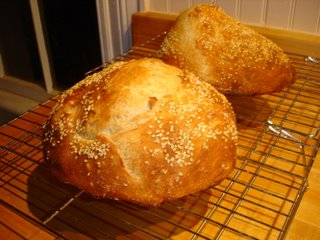 The crazy loaf in the back is the one I had some problems with as I was transfering it from counter to baking sheet with the bench knife: the bottom ended up on the top.
The crazy loaf in the back is the one I had some problems with as I was transfering it from counter to baking sheet with the bench knife: the bottom ended up on the top.
Glossy, crackly crust; high, holey crumb; chewy; pretty good flavor with the right amount of salt. Here's how it looked this morning:
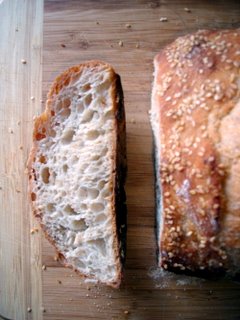
Changes for next time: I'll make the dough ever so slightly less wet. I'll remember to save some of the dough to use as a sour starter for the time after that, because it would be much better if it had a little more tang. Also I'd like to try it with rye, as it's been years and years since I've made good rye bread (I did it once, in Queens, and never managed to replicate it).
I've been dipping in and out of Nina Planck's Real Food since I bought it yesterday. (I went to high school with her in Loudoun County, Virginia, but she was a couple years ahead of me and I didn't really know her.) So far it's pretty smart, although Mr. Chalmers is not a fan of the climate-based explanation for the lack of milk consumption in East and Southeast Asia—and he's right that it's more likely just cultural (see Italy, Greece, China: hot places with cheese traditions and a cold place with no milk-drinking or cheesemaking at all). Despite the book's use of discredited essentialist anthropological theories it's making me want to make real yogurt. So look for that story here soon.
Yesterday the Chalmerses went into Athens. We went to the bookstore, made a quick stop at the Kroger, then went downtown and had coffee and read for an hour or so. It was overcast and windy, but warmer than it has been. Town was quiet, perhaps because of the holiday or the away game at Auburn. The bug was happy to sit outside with us, and she let us finish our coffee at our own pace and read peacefully until we were ready to leave. Her eyes were especially blue yesterday, it seems.
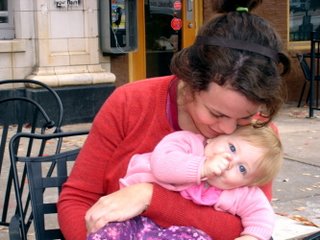
She'd written to me a month or so ago about her own new way of making bread, letting a biga (starter) rise very slowly in the fridge for a long time (she uses stuff like wine dregs for the yeast). So Friday afternoon I decided to wing it and try a combination of all of these techniques. Unfortunately I didn't keep track of amounts, or take in-progress pictures, but I'll do that next time. Here's what I did, though, in broad strokes:It's very good. Very tough crisp crust. The interior is holey, soft, and moist. The flavor is OK. mild. I think I prefer more bready flavor, more yeasty, more sour. This is like white bread. Which it is. Lately I've been making a bread with overnight starter and part whole wheat flour, and it has more flavor. The crust of this today is kind of almost shiny smooth, it is not dry & crumbly. Yet. It is more crisp than chewy. It looks as if it were glazed--nice golden brown, but of course lumpy & rough with bran.The hard part was the pot. Even the biggest Corning ware pot was not big enough. I have a lid for a smaller dutch oven. To find a 6 to 8 quart size meant using one that does not have a lid. So I put heavy duty foil on it & held that down with a lid that almost fit. I figured that even though it's only one little loaf, the size of the pot must have something to do with the air in there. If it were smaller, the bread might burn?But using that big pot for one loaf seemed like overkill, and I usually do at least 2 loaves at a time. Often 4. One little loaf is not worth that much effort, especially when I can get good bread with normal methods--kneading isn't that hard! And the water squirt in the oven works. The most important thing I think is the long cool rise. And I can make more bread without taking up the whole oven for one hour at 450 degrees for one loaf.But I sure can't complain about it--it's very good--a bit dark on the bottom, hard to cut, but nice & chewy. It is a big blob--no shape to it. I used lots of bran & should have used more--it stuck to the cloth. You need a good new linen towel that is stiff--I used an old piece of limp linen, & with dips in the wrinkles, the bran did not get completely over it. But it did not stick to the pot at all.
Friday afternoon: Combined lots of cold water in a big ceramic bowl with just 1/2 teaspoon instant yeast, about 1 cup whole-wheat flour, and about 2 cups bread flour and stirred until smooth. It was like a very runny batter. Put it in the fridge overnight.Here's what I got:
Saturday morning: Added more cold water and another 1/2 teaspoon instant yeast, then stirred in 2 1/2 teaspoons kosher salt and just enough bread flour to make a wet, very sticky, shaggy dough—too wet to turn out onto the counter; I left it in the bowl, covered, for about 4 hours at cool room temperature.
Saturday afternoon: Turned the dough out onto the counter, sprinkled with a little flour, and used a bench knife to fold it over on itself a few times. Washed the bowl and very lightly greased it with olive oil. Put the dough blob back into the bowl and let it rise for about 6 hours, covered, at cool room temperature. It's still very wet. Every once in a while I'd use a rubber spatula to fold the edges of the dough over and into the middle, pulling the dough from the bottom up and over itself and gently pressing down on the mound. It wasn't rising very much, but it was getting stretchy. Still wet.
Saturday night (about 8 p.m.): Used a spatula to turn the dough out onto the counter, then cut it into two portions. Again using the bench knife I formed the pieces into roughly round balls (it was still so wet that it was hard to form the dough at all), then transfered them to a cornmeal-sprinkled baking sheet. Brushed the tops with water and sprinkled with sesame seeds. The balls were more like flat disks, heavy with the weight of the wetness. I let the loaves sit just until the oven was preheated to 450 degrees, then put them in, threw a couple ice cubes in the bottom of the oven, and baked for about 30 minutes.
 The crazy loaf in the back is the one I had some problems with as I was transfering it from counter to baking sheet with the bench knife: the bottom ended up on the top.
The crazy loaf in the back is the one I had some problems with as I was transfering it from counter to baking sheet with the bench knife: the bottom ended up on the top.Glossy, crackly crust; high, holey crumb; chewy; pretty good flavor with the right amount of salt. Here's how it looked this morning:

Changes for next time: I'll make the dough ever so slightly less wet. I'll remember to save some of the dough to use as a sour starter for the time after that, because it would be much better if it had a little more tang. Also I'd like to try it with rye, as it's been years and years since I've made good rye bread (I did it once, in Queens, and never managed to replicate it).
I've been dipping in and out of Nina Planck's Real Food since I bought it yesterday. (I went to high school with her in Loudoun County, Virginia, but she was a couple years ahead of me and I didn't really know her.) So far it's pretty smart, although Mr. Chalmers is not a fan of the climate-based explanation for the lack of milk consumption in East and Southeast Asia—and he's right that it's more likely just cultural (see Italy, Greece, China: hot places with cheese traditions and a cold place with no milk-drinking or cheesemaking at all). Despite the book's use of discredited essentialist anthropological theories it's making me want to make real yogurt. So look for that story here soon.
Yesterday the Chalmerses went into Athens. We went to the bookstore, made a quick stop at the Kroger, then went downtown and had coffee and read for an hour or so. It was overcast and windy, but warmer than it has been. Town was quiet, perhaps because of the holiday or the away game at Auburn. The bug was happy to sit outside with us, and she let us finish our coffee at our own pace and read peacefully until we were ready to leave. Her eyes were especially blue yesterday, it seems.

Friday, November 10, 2006
Little Project
I can't really make anything major these days—sewing-, knitting-, or otherwise-wise—but I did manage to rig up a canopy over the bug's bed the other day, to trap heat, absorb sounds (in particular this bizarre new sound she makes whenever she's standing up, and most other times too), and to make her area a little cozier: twelve-foot ceilings are pretty but decidedly uncozy.
 I suspended two shower curtain rods from the ceiling (which is beadboard, so it's easy to screw hooks into), and braced them apart with a piece of bamboo I found in the pantry. Then two sections of material are draped over them and kept from slipping with a little double-stick tape. Impermanent, maybe, but it works. The mobile is a bit of a fly in the ointment, but eventually I'll get around to fixing the height so it clears the canopy but is still out of bug reach. So far the canopy has not improved anyone's sleep. The bug is waking up every two hours to stand up and growl in the dark.
I suspended two shower curtain rods from the ceiling (which is beadboard, so it's easy to screw hooks into), and braced them apart with a piece of bamboo I found in the pantry. Then two sections of material are draped over them and kept from slipping with a little double-stick tape. Impermanent, maybe, but it works. The mobile is a bit of a fly in the ointment, but eventually I'll get around to fixing the height so it clears the canopy but is still out of bug reach. So far the canopy has not improved anyone's sleep. The bug is waking up every two hours to stand up and growl in the dark.
 I suspended two shower curtain rods from the ceiling (which is beadboard, so it's easy to screw hooks into), and braced them apart with a piece of bamboo I found in the pantry. Then two sections of material are draped over them and kept from slipping with a little double-stick tape. Impermanent, maybe, but it works. The mobile is a bit of a fly in the ointment, but eventually I'll get around to fixing the height so it clears the canopy but is still out of bug reach. So far the canopy has not improved anyone's sleep. The bug is waking up every two hours to stand up and growl in the dark.
I suspended two shower curtain rods from the ceiling (which is beadboard, so it's easy to screw hooks into), and braced them apart with a piece of bamboo I found in the pantry. Then two sections of material are draped over them and kept from slipping with a little double-stick tape. Impermanent, maybe, but it works. The mobile is a bit of a fly in the ointment, but eventually I'll get around to fixing the height so it clears the canopy but is still out of bug reach. So far the canopy has not improved anyone's sleep. The bug is waking up every two hours to stand up and growl in the dark.
Wednesday, November 08, 2006
Hog: Part 1
Here's the hog hanging in the garage. The slaughterer left the halves attached at the bottom and at the top so it wouldn't flop apart when my parents sawed it into sixths.
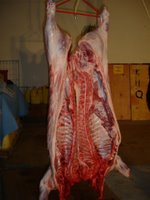 My dad is cutting the chine bone out with a twenty-dollar reticulating saw so that it'll be easier to separate the ribs into chops. My mom almost lost her arm at least twice. My folks don't always wear matching red shirts:
My dad is cutting the chine bone out with a twenty-dollar reticulating saw so that it'll be easier to separate the ribs into chops. My mom almost lost her arm at least twice. My folks don't always wear matching red shirts:
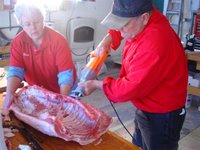 In the foreground are the ribs, which have been separated from the bacon and the part of the ribs you use for chops. My mom is trimming fat, I think. That's a big pile of it next to the lard pot:
In the foreground are the ribs, which have been separated from the bacon and the part of the ribs you use for chops. My mom is trimming fat, I think. That's a big pile of it next to the lard pot:
 Chops ready for the freezer:
Chops ready for the freezer:
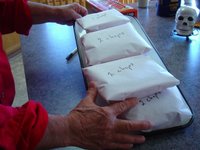
Sausage being made. The gray stuff off to the left is the liver, which Mom and Dad froze for later use in liverwurst. The white stuff is fat, of course, some of which went into the sausage and some of which was rendered for lard. The KitchenAid meat grinder/sausage stuffer attachment worked really well. It started to heat up at about pound twelve, but how often does a person want to make more than twelve pounds of sausage anyway?
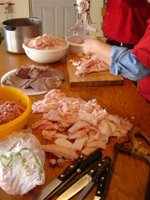
This is andouille (salt, cracked pepper, garlic, cayenne, thyme), which Dad smoked the next day:
 Breakfast of pann haas, fried in bacon fat. We made about ten loaves of it:
Breakfast of pann haas, fried in bacon fat. We made about ten loaves of it:
 The hams were all that was left to take care of as it was getting light outside (we were all up with the bug at 3:30 that morning and just went ahead and started the job, so it was pretty much done by noon). After the bulk of the butchering was over, Dad put a fresh piece of cardboard underneath the hook just in case he got a deer that evening. In fact, he had one in his sights later, but decided to let it live. As he said, that deer was lucky we'd just butchered a whole hog.
The hams were all that was left to take care of as it was getting light outside (we were all up with the bug at 3:30 that morning and just went ahead and started the job, so it was pretty much done by noon). After the bulk of the butchering was over, Dad put a fresh piece of cardboard underneath the hook just in case he got a deer that evening. In fact, he had one in his sights later, but decided to let it live. As he said, that deer was lucky we'd just butchered a whole hog.
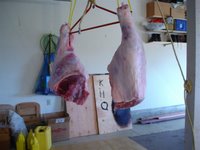
 My dad is cutting the chine bone out with a twenty-dollar reticulating saw so that it'll be easier to separate the ribs into chops. My mom almost lost her arm at least twice. My folks don't always wear matching red shirts:
My dad is cutting the chine bone out with a twenty-dollar reticulating saw so that it'll be easier to separate the ribs into chops. My mom almost lost her arm at least twice. My folks don't always wear matching red shirts: In the foreground are the ribs, which have been separated from the bacon and the part of the ribs you use for chops. My mom is trimming fat, I think. That's a big pile of it next to the lard pot:
In the foreground are the ribs, which have been separated from the bacon and the part of the ribs you use for chops. My mom is trimming fat, I think. That's a big pile of it next to the lard pot: Chops ready for the freezer:
Chops ready for the freezer:
Sausage being made. The gray stuff off to the left is the liver, which Mom and Dad froze for later use in liverwurst. The white stuff is fat, of course, some of which went into the sausage and some of which was rendered for lard. The KitchenAid meat grinder/sausage stuffer attachment worked really well. It started to heat up at about pound twelve, but how often does a person want to make more than twelve pounds of sausage anyway?

This is andouille (salt, cracked pepper, garlic, cayenne, thyme), which Dad smoked the next day:
 Breakfast of pann haas, fried in bacon fat. We made about ten loaves of it:
Breakfast of pann haas, fried in bacon fat. We made about ten loaves of it: The hams were all that was left to take care of as it was getting light outside (we were all up with the bug at 3:30 that morning and just went ahead and started the job, so it was pretty much done by noon). After the bulk of the butchering was over, Dad put a fresh piece of cardboard underneath the hook just in case he got a deer that evening. In fact, he had one in his sights later, but decided to let it live. As he said, that deer was lucky we'd just butchered a whole hog.
The hams were all that was left to take care of as it was getting light outside (we were all up with the bug at 3:30 that morning and just went ahead and started the job, so it was pretty much done by noon). After the bulk of the butchering was over, Dad put a fresh piece of cardboard underneath the hook just in case he got a deer that evening. In fact, he had one in his sights later, but decided to let it live. As he said, that deer was lucky we'd just butchered a whole hog.
Tuesday, November 07, 2006
He's a Pretty Clean Dog
Sorry: I still don't have hog pictures. But here are a few of the bug, who's been a sweet little terror the last few days. I'm betting we see a tooth before the week's out, as she's been making a funny face where she sucks her lips in and smacks them like an old lady, and she's been unusually fussy and unable to sleep well (the latter could have something to do with the fact that she stands up in her crib the second she's even partly awake, which makes it hard for her to fall back to sleep on her own and results in twenty-minute naps and frequent nighttime wakings).
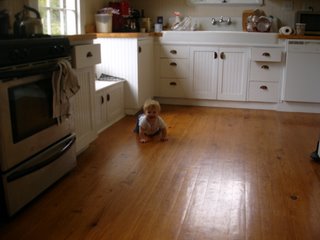 We've been letting her crawl free as much as possible; the kitchen is relatively safe now, though she's always finding something we haven't thought of (a stack of newspapers on the window seat, a spilled coffee bean god help us), and there isn't much we can do about the garbage can she loves so dearly.
We've been letting her crawl free as much as possible; the kitchen is relatively safe now, though she's always finding something we haven't thought of (a stack of newspapers on the window seat, a spilled coffee bean god help us), and there isn't much we can do about the garbage can she loves so dearly.
The other day I caught her sleeping on Wagner, and then, of course, she promptly woke up.
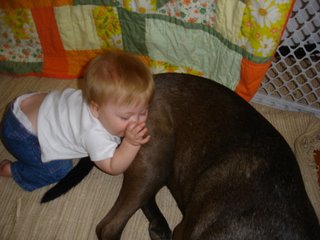

 We've been letting her crawl free as much as possible; the kitchen is relatively safe now, though she's always finding something we haven't thought of (a stack of newspapers on the window seat, a spilled coffee bean god help us), and there isn't much we can do about the garbage can she loves so dearly.
We've been letting her crawl free as much as possible; the kitchen is relatively safe now, though she's always finding something we haven't thought of (a stack of newspapers on the window seat, a spilled coffee bean god help us), and there isn't much we can do about the garbage can she loves so dearly.The other day I caught her sleeping on Wagner, and then, of course, she promptly woke up.


Subscribe to:
Posts (Atom)

